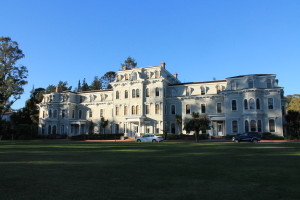Mills Train, an interdisciplinary exhibition organized by the Mills College Art Museum (MCAM), chugged across campus in a collaborative celebration of dance, art, music, and poetry, all in the spirit of Patti Smith with its own, unique Mills twist.
Three hours of ongoing events were scheduled throughout campus on the evening of Oct. 12, allowing art enthusiasts to wander from “station” to “station,” experiencing the varied forms of art produced by Mills students, staff, and faculty.

The exhibition was an offshoot of the expansive new Patti Smith exhibit featured at MCAM, the library, and the book art building. It was inspired by Smith’s latest book “M Train,” which, according to the MCAM website, “refers to a ‘mind train’ that gets off at any station it wants.”
The idea for the event was proposed by MCAM program director Jayna Swartzman-Brosky, and jointly planned with museum director Stephanie Hanor.
“It seemed like an excellent opportunity to take advantage of all the talent and artistic offering that we have on campus and engage it with the exhibition that we have on Patti Smith’s work,” Swartzman-Brosky said. “And also to tie the campus together, to all celebrate each other.”
Students in the book art club set up their own station in a classroom in CPM, guiding participants through the construction of papercrafts for the duration of the evening. Club members were excited to show the continued strength of their program to Mills community members after recent budget cuts nearly eliminated the book art department.
“The book art department really wants to, in light of everything that happened last year, show that we are connected to this campus,” Danni Anderson, book art minor and club member, said. “It was fun, we had a great time.”

Each station featured ongoing performances and installations for at least one hour of the three-hour exhibition to ensure that everyone had the opportunity to experience each station.
The opening event was a convergence of music and book arts, combining the improvisational music skills of music professor Fred Frith with students from his Musical Improv II class and book arts students who used printing presses to simultaneously make music and produce broadside prints of one of Patti Smith’s poems.
Students used a range of traditional instruments and unconventional materials to produce sound, ranging from violin to tin can against a drum. Joel Nelson, a graduate student in the music department, played guitar during the performance.
“I had no idea really [what to expect],” Nelson said. “I thought it went really great.”
Though the idea for the event started at the museum, Mills Train really took off once the faculty got involved.
“It was really a group effort,” Swartzman-Brosky said. “We just kind of made space for having a conversation about how we could collaborate and they were all in.”
Faculty members led most of the events, bringing together their many departments into a unique, interactive experience for the whole campus to enjoy. Creative writing and Latin American studies professor Carlota Caulfield led a “Walking Magazine” from the book arts building all the way to MCAM, reciting spoken work poetry as she led the march. Once the procession arrived at MCAM, a multi-part performance of dance and music unfolded in the courtyard, pulling the physical space of the buildings, right down to the freshly fallen leaves gathered on the steps, into the art. The evening was capped by a poetry reading in the new Slide Space 123 gallery, which included the works of professors like Stephanie Young and Stephen Ratcliffe.
The Mills Train laid its tracks all across the school, weaving its ongoing performances into the fabric of the campus.
“There’s a very experimental nature to the arts here at Mills and it’s nice to be able to highlight that,” Hanor said.
“And this is an experiment!” Swartzman-Brosky added.
This event is the first of its kind, but Hanor and Swartzman-Brosky hope that, if the campus community was inspired by Mills Train, it could be brought back to show off the talents and skills of Mills students and faculty into the future.



